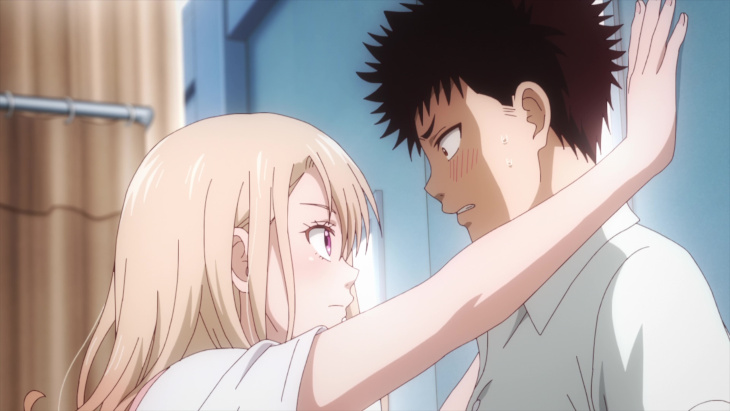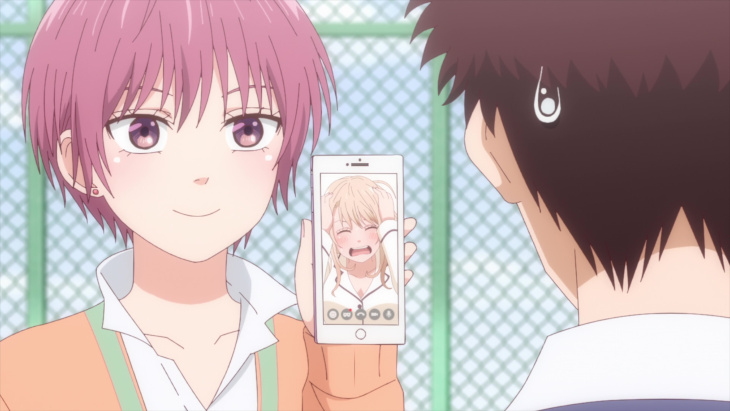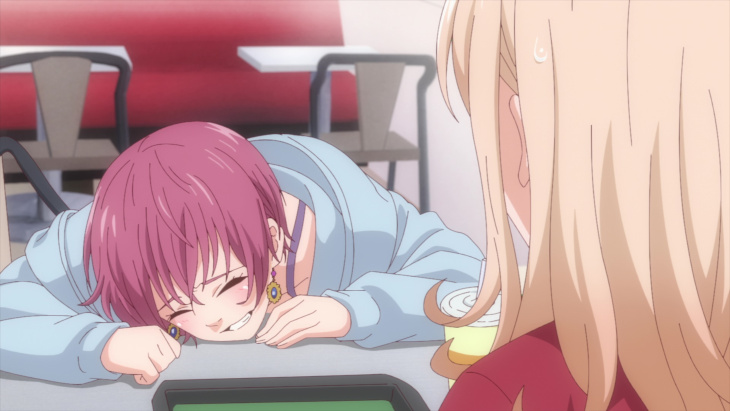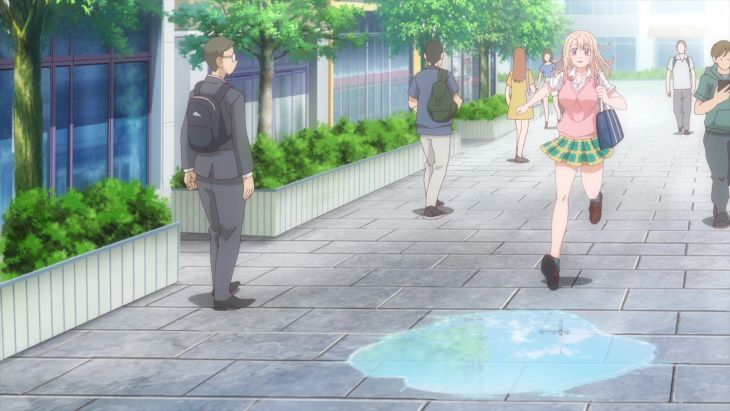
“Mona Kawai, seventeen years old. Osaka born and bred. A girl who charms as easily as she breathes. A girl who for the first time in her life… finds herself in love.”
I find romantic comedies to be among the more difficult shows to write First Impressions reviews for, which is the key reason I skipped writing one for Medaka Kuroiwa Is Impervious to My Charms at the beginning of the season. I wasn’t comfortable writing a positive review for it, as it did mainly come across as a trashy comedy that didn’t have anything going for it beyond its jokes. On the other hand, I didn’t actually dislike the characters, and the jokes landed for me more than they didn’t, so I wasn’t comfortable writing a negative review either. Even putting it in the middle didn’t seem right. However, having reached the end of the season, I think I’m satisfied putting it down as a thoroughly middling show.
To be fair, I’ve heard the source material improves once it moves beyond its central joke, but the anime evidently didn’t feel the urge to take any shortcuts. With stiff animation, repeated jokes, and glacial progression, the only thing the show can boast is good chemistry between its extended cast. While that keeps the show from becoming intolerable, it can’t save it from becoming stale. If you’re curious about this one, you’re probably better off reading the source material.

Medaka Kuroiwa’s premise is also roughly 80% of its jokes. Mona Kawai is a girl who has never been left wanting for anyone’s attention. Her beauty and charm have immediately enraptured everyone she’s encountered, with one singular exception, her high school classmate Medaka Kuroiwa. Despite her best efforts, Mona finds she’s the recipient of a cold shoulder every time she attempts to connect with Medaka, a development that threatens her ego as a self-proclaimed queen bee. As a result, Mona takes a strong “Keikaku doori” (Translator’s note: “keikaku doori” means “all according to keikaku” (Translator’s note: keikaku means plan)) approach to charming Medaka, using fanservice and innuendo like it’s 3-dimensional chess. Unbeknownst to her, Medaka doesn’t actually dislike Mona, but as a monk-in-training, he’s attempting to remain chaste, and avoid excessive contact with female students.
This does reek of the series trying to have its cake and eat it too. There’s no reason for Medaka’s association with the temple to not be public knowledge, but for some reason, he only tells two characters during the course of the season. Admittedly, the humor did get a couple laughs out of me, particularly early on, so I can’t be too high and mighty when criticizing the comedy. Still, the jokes between Mona and Medaka don’t evolve much throughout the season. To make matters worse, the show loves to rely on unlikely gags to progress the plot. We all know the type. A bit of physical comedy that isn’t funny, but can be relied on to force the characters into a situation that the writer wants. Medaka Kuroiwa is awash with those moments, and it always feels cheap and unearned.

The one instance that provides some fresh laughs are the characters in their orbit. This mostly comes in the form of romantic rivals and friends, who gradually hammer away at Mona’s constant assertions that she’s not romantically interested in Medaka. The varying personalities allow for some fun gags, though even those start to feel worn-out after a few episodes. Regardless, they offer some twists on the base formula, which helps the show avoid becoming insufferable.
On the other hand, it also doesn’t help that Mona remains committed to her denial far longer than is reasonable, even for a comedy. Hell, her denial over the situation ends up feeling even more forced than the monk-in-training plot point. For a while, part of me suspected the manga probably would end with Mona proclaiming on their honeymoon that it’s still all about her goal of being the object of everyone’s affection.
Without spoiling too much, the final stretch of the show introduces a shift in the status quo. Although those episodes continue to use messy narrative shortcuts, the actual humor and heart of the final episode is leagues above most of the episodes that preceded it. In essence, if the show had gotten to the finale 5 episodes earlier, I’d probably be feeling a bit more kindly towards this show.

The production for Medaka Kuroiwa Is Impervious to My Charms was handled by SynergySP. Part of me would like to tear the animation a new one, given how stiff and robotic the movement can be, but it’s come to my attention that it’s already been thoroughly mocked online, so I almost feel like I should take an apologist stance. If you were to ask me what the production’s biggest failing was, I’d say it was allowing the weakest animation to be prominent in the most commonly viewed visuals. The awkward dancing in the OP has understandably been ridiculed, and I quickly noticed that a recurring segment at the start of many early episodes featured distractingly bad running animation. While the motion is never good, those are probably among the most egregious examples.
This flies in the face of production logic. The more often a viewer will see something, the more unassailable it should be. From that perspective, Medaka Kuroiwa’s failure to make even its OP look passable seems incredibly backwards. I’m not about to argue that the remainder of the show looks good. It’s firmly on the lower end of modern animation quality, but I’ve seen far worse. Hell, Last Dungeon Boonies barely grasped the concept of staying on model.
I was quick to call out this show’s visuals on social media, and the visual quality is definitely on the lower end, so there’s only so much I can defend it. Still, it doesn’t even come close to being the ugliest show of the season. Go Hands makes sure of that. Aside from the questionable production values, the OP and ED are forgettable overall. Even if the visuals were up to par with contemporary shows, I think the bubblegum-pop audio would be written-off regardless.
Before I wrap up, a few Notes and Nitpicks:
- Earlier in the review, I mentioned using gags to progress that plot, and I wanted to provide an example. At one point, both Medaka and Mona drop and break their phones in exactly the same way! It’s played off as a joke, but it wasn’t funny, and the one reason for it is so the characters can be separated from a group for a bit. There are so many ways that this could have been explained away without having to rely on that gag, but the writer took the lazy way out.
- I’m not familiar enough with the traditions of Japanese temples, but the idea of a temple that requires abstinence and is handed down through the family seems a tad… contradictory. I suppose one child from each generation of the extended family could take on that role, but they never dive into the logistics, and it bugs me.
- The last show I watched from SynergySP was Cross Game… which wrapped up 15 years ago! The production on that show was fine, but it was the writing that made it notable. The studio appears to be increasing its output lately, and I wonder if they’re exceeding their capabilities.
- The irony is, I enjoyed the last episode, despite how tired I was of this show by that point. That’s how refreshing the final narrative shake-up was.
- I’m not going to lie. I never thought we’d hear from this anime again, but a second season has evidently been announced.
My feelings on Medaka Kuroiwa remain mixed. There are moments where I find the show charming and funny, but even then it verges on being a guilty pleasure more than anything else. Plus, those moments are the minority in this season. As a result, I don’t think I can recommend this series to anyone. Even if I thought someone might like the set-up, the animation and execution are such a weight around its neck that I’d suggest they look elsewhere. Watch ToraDora.




Add comment